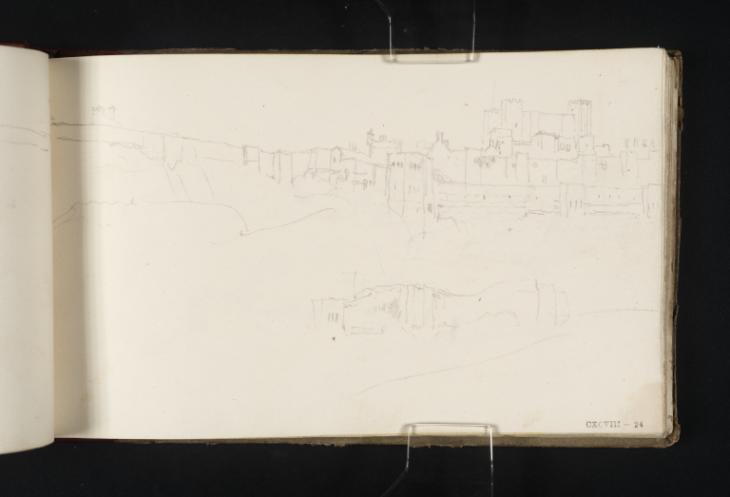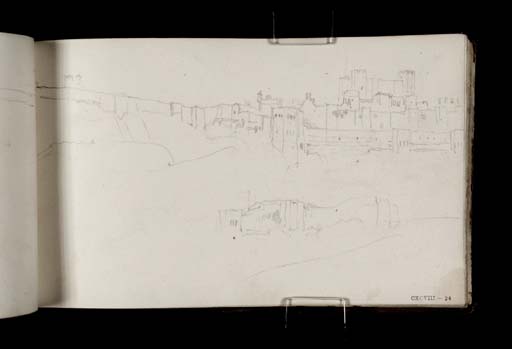Joseph Mallord William Turner Dover Castle c.1821-2
Image 1 of 2
Joseph Mallord William Turner,
Dover Castle
c.1821-2
Joseph Mallord William Turner 1775–1851
Folio 24 Recto:
Dover Castle c.1821–2
D17247
Turner Bequest CXCVIII 24
Turner Bequest CXCVIII 24
Pencil on white wove paper, 113 x 187 mm
Stamped in black ‘CXCVIII – 24’ bottom right
Stamped in black ‘CXCVIII – 24’ bottom right
Accepted by the nation as part of the Turner Bequest 1856
References
1909
A.J. Finberg, A Complete Inventory of the Drawings of the Turner Bequest, London 1909, vol.I, p.604, CXCVIII 24, as ‘Rochester or Dover Castle (?)’.
Made across this and the facing page on folio 24 recto (D17247), this drawing describes Dover Castle and its surrounding buildings. The present page demonstrates the structure of the castle itself, and carefully observes the cluster of stone buildings which stand in front of and encircle it. Finberg was reluctant to choose between Rochester and Dover, although he too recognised the form of a castle in this sketch.1
The site is thought to have been occupied by a fort since the Iron Age.2 William the Conqueror strengthened defences on the Dover cliffs after his victory at Hastings in 1066, introducing earthwork and a timber-stockaded castle which was then garrisoned continuously until 1958. The great tower dates from the 1180s, and was a strategic addition by Henry II in both a symbolic and defensive sense. Turner records this structure towards the top right of the page. It is 25.3 metres high, about 30 metres square, and has walls up to 6.5 metres thick. Building work on the castle did not reach completion until the reign of Henry III, who oversaw the installation of rings of defensive walls around the site which are evident in Turner’s sketch. He also added three further gatehouses and a fortified spur extension, and is generally responsible for the appearance of the fortress today.3
At the bottom of this page is what appears to be a secondary sketch, somewhat disconnected from the main image. Groups of vertical lines, possibly small towers or gatehouses, appear at regular intervals linked vaguely by connecting marks. This might be a study of a section of one of the successive rings of walls which surround the castle, although it is difficult to identify definitively the subject or location.
For further drawings which explore the castle in this sketchbook, see folios 23 verso–24 recto, 29 verso–30 recto, 47 verso, and 48 verso–49 recto (D17246–D17247, D17256–D17257, D17286, and D17288–D17289). For drawings from the 1810s, see two pages from the Hastings Sketchbook of about 1816–18 (Tate D10363–D10364; Turner Bequest CXXXIX 18a–19), and four from the Richmond Hill; Hastings to Margate sketchbook from around 1816–19 (Tate D10456, D10468, D10470 and D10579; Turner Bequest CXL 25, 31, 32, and 86a). Later sketches continuing the theme can also be found in the Holland sketchbook of 1825 (Tate D18841, D19349–D19357, D19359, D19374, D19378, D19380, D19381; Turner Bequest CCXIV 1, 256a–260a, 261a, 269, 271, 272, 272a), the similarly dated Holland, Meuse and Cologne sketchbook of about 1825 (Tate D19406, D19407, and D19413; Turner Bequest CCXV 3a, 4, and 7), and the Dover, Rhine and Innsbruck sketchbook of 1843 (Tate D31223–D31225; Turner Bequest CCCIX 1–2a).
Elsewhere in the Tate collection, see early watercolours Dover: The Castle and Pier from the Harbour of 1793 (Tate D00163; Turner Bequest XVI A), Dover: A Two-Master in the Harbour, with Castle Beyond of 1795–6 (Tate D36617; Turner Bequest CCCLXXVIII 2), and Dover Harbour: Shipping, with the Castle Beyond of 1795–6 (Tate D36622; Turner Bequest CCCLXXVIII 7). For watercolours dating from slightly later than the present book, see leaves in the Ports of England sketchbook from around 1822–3 (Tate D17732, D17737; Turner Bequest CCII 13, 18), the latter of which is considered to be a preparatory design for the watercolour Dover, from Shakespeare Cliff of about 1824 (currently untraced),4 engraved by G. Cooke and published in 1826 for Southern Coast (Tate impressions: T04424, T05246–T05251, T06000). See also Dover Castle from the Sea: Preparatory Study of 1822 (Tate D25502; Turner Bequest CCLXIII 378) and Dover Castle with the English Channel Beyond produced around 1825–38 (Tate D25308; Turner Bequest CCLXIII 186). Elsewhere, see Dover Castle from the Sea (Museum of Fine Arts, Boston).
Maud Whatley
January 2016
‘History of Dover Castle’, English Heritage, accessed 5 November 2015, http://www.english-heritage.org.uk/visit/places/dover-castle/history/ .
How to cite
Maud Whatley, ‘Dover Castle c.1821–2 by Joseph Mallord William Turner’, catalogue entry, January 2016, in David Blayney Brown (ed.), J.M.W. Turner: Sketchbooks, Drawings and Watercolours, Tate Research Publication, February 2017, https://www


